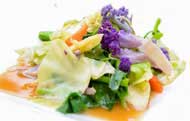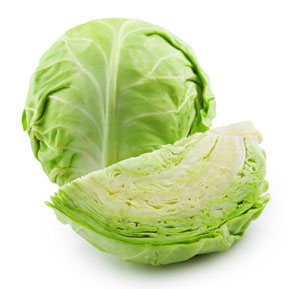





1. Cabbage Facts
2. Types of Cabbage
2. Cabbage Nutritional Value
3. Cabbage Health Benefits
Cabbage (Brassica oleracea or variants) is a leafy green or purple vegetable. Cabbage is a very powerful vegetable with ancient healers declaring it to contain "moon power", as it grew in the moonlight. It has a very high sulphur and Vitamin C content.
History and Origin
Whilst it is not completely clear where cabbage originated, it is thought that it dates back to a province in China around 4,000 BC. It is then believed to have been transported to the Mediterranean region of Europe around 600 BC. Research indicates it was a domesticated vegetable during Greek and Roman times. It is known as one of the oldest of all vegetables.
Cabbage is considered one of the main vegetables in Russia with it being a key ingredient in some of their main national soups. Chinese scrolls from 1,000 BC regarded white cabbage as a cure for baldness in men. It is reported that during Captain Cook's first voyage in the 17th century, the ship's doctor used cabbage in a poultice to wrap around the wounds of any injured crew members, to stop gangrene from setting in.
- • Green Cabbage
- • Red or Purple Cabbage
- • Napa Cabbage
- • Savoy Cabbage
- • Bok Choy
- • Choy Sum
- • Tuscan Cabbage
- • Gai Choy
Vegetables " Cabbage " ( Nutritional value )
Nutritional value per 100 g
Cabbage, cooked, boiled, drained, without salt
|
Nutrient ( Proximate's )
|
Unit
|
Value
|
Daily Value %
|
|
Energy
|
kcal
|
23
|
1.1%
|
|
Protein
|
g
|
1.27
|
2.5%
|
|
Total lipid (fat)
|
g
|
0.06
|
0.0007%
|
|
Carbohydrate, by difference
|
g
|
5.51
|
2%
|
|
Fiber, total dietary
|
g
|
1.9
|
6.7%
|
|
Sugars, total
|
g
|
2.79
|
|
|
Minerals
|
|||
|
Calcium, Ca
|
mg
|
48
|
3.6%
|
|
Iron, Fe
|
mg
|
0.17
|
0.9%
|
|
Magnesium, Mg
|
mg
|
15
|
3.5%
|
|
Phosphorus, P
|
mg
|
33
|
2.6%
|
|
Potassium, K
|
mg
|
196
|
4.1%
|
|
Sodium, Na
|
mg
|
8
|
0.003%
|
|
Zinc, Zn
|
mg
|
0.20
|
1.8%
|
|
Copper, Cu
|
mg
|
0.017
|
1.8%
|
|
Manganese, Mn
|
mg
|
0.205
|
8.9%
|
|
Selenium, Se
|
mcg
|
0.6
|
1%
|
|
Fluoride, F
|
mcg
|
1.0
|
|
|
Vitamins
|
|||
|
Vitamin C, total ascorbic acid
|
mg
|
37.5
|
41.6%
|
|
Thiamin (B-1)
|
mg
|
0.061
|
5%
|
|
Riboflavin (B-2)
|
mg
|
0.038
|
2.9%
|
|
Niacin NE (niacin) (B-3)
|
mg
|
0.248
|
1.5%
|
|
Pantothenic acid (B-5)
|
mg
|
0.174
|
3.4%
|
|
Vitamin B-6
|
mg
|
0.112
|
6.5%
|
|
Folate DFE (dietary folate) (B-9)
|
mcg |
30
|
7.5%
|
|
Vitamin B-12
|
mcg
|
0.00
|
|
|
Vitamin A, RAE (retinol)
|
mcg
|
4
|
0.4%
|
|
Vitamin E (alpha-tocopherol)
|
mg
|
0.14
|
0.9%
|
|
Vitamin D (D2 + D3)
|
mcg
|
0
|
|
|
Vitamin K (phylloquinone)
|
mcg |
108.7
|
90.5%
|
|
Lipids
|
|||
|
Saturated Fatty Acids
|
g
|
0.000
|
|
|
Monounsaturated Fatty Acids
|
g
|
0.019
|
|
|
Polyunsaturated Fatty Acids
|
g
|
0.023
|
|
|
Trans Fatty Acids
|
g
|
0.000
|
|
|
Carotenoids
|
|||
|
Beta-Carotene
|
mcg
|
48
|
|
|
Lutein + zeaxanthin
|
mcg
|
27
|
|
|
Lycopene
|
mcg
|
0
|
|

|
Reference Values are based on a 2,000 Calorie Intake, for Adults and Children 4 or More Years of Age. Your daily values may be higher or lower depending on your calorie needs.
|
|
Percentages are roughly approximated using (RDA) Recommended Dietary Allowances for adults. Source: Nutrient Database - USDA (United States Department of Agriculture)
|
|
Reference Values for Nutrition - FDA U.S. Food and Drug Administration
|
Cabbage Nutritional Value
It is reported that during Captain Cook's first voyage in the 17th century, the ship's doctor used cabbage in a poultice to wrap around the wounds of any injured crew members, to stop grangrene from setting in.
Red cabbage is a greater source of Vitamin C than white cabbage and interestingly enough, oranges. Red cabbage contains the same red flavonoid pigments as red and blue berries, which are all regarded as super antioxidants. Studies indicate that white cabbage contains high levels of sulphur-comprising compounds, much higher than many other Brassica vegetables, however the red cabbage is believed to have even higher levels. Red cabbage is a very high source of Vitamin K, however the green cabbage is the winner in the Vitamin K stakes.
Cabbage is low in calories and high in fiber, therefore is a great dietary source. Being full of vitamin K, it is thought to help prevent Alzheimer’s disease and is a great source for mental function and concentration and help with bone density. The high content of vitamin C and sulphur in cabbage removes toxins from the body, helping arthritis, gout, rheumatism and skin diseases. The high potassium levels helps stop blood pressure from rising. It is believed that a drinking raw cabbage juice on a daily basis can relieve chronic headaches. The red pigments in red cabbage are said to lower blood sugar levels and increase insulin production. The powerful antioxidants in cabbage are believed to reduce bad blood cholesterol levels.
Cabbage has historically been used as a medicinal herb for a variety of health benefits. The ancient Greeks used cabbage as a laxative and cabbage juice as a liniment for bruises. The ancient Romans believed that drinking cabbage juice was a cure for hangovers. There is scientific evidence to corroborate the use of cabbage leaves to ease the pain of engorged breasts in nursing mothers, during breast feeding.
The downside of this vegetable is excessive consumption can lead to increased intestinal gas, which causes bloating and flatulence.
- WEIGHT LOSS
Low in calories and high in fibre - ARTHRITIS / RHEUMATISM / GOUT
High in vitamin C and sulphur - REDUCE HIGH BLOOD PRESSURE
High potassium levels - ENGORGED BREASTS
The cool effect of cabbage leaves relieves the associated pain

- ALZHEIMERS PREVENTION
Rich in vitamin K - SKIN DISEASES
Antioxidants removing toxins - DIABETES
Red pigments lower blood sugar levels and increases insulin production - CHRONIC HEADACHES
The anti-inflammatories and antioxidants found in cabbage juice
References
|
Nutrient Database - USDA (United States Department of Agriculture)
|
|
Reference Values for Nutrition - FDA U.S. Food and Drug Administration
|
For More Information
|
Cabbage & Health benefits - From Wikipedia, the free encyclopedia
|
|
Share
|
